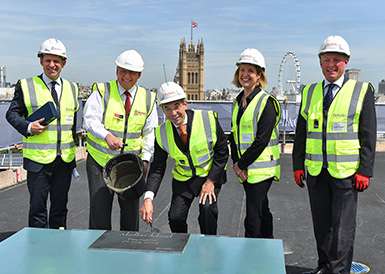Deputy Leader of Westminster City Council, Cllr Robert Davis today joined Berkeley Homes founder, Tony Pidgley, and architect Deborah Saunt to 'top out' the final floor of Berkeley's prime new development, Abell & Cleland.
The 'topping out' at Abell House - the first of two buildings - was attended by 40 key officials from Westminster, the Greater London Authority and Community Working Group. They were able to see first-hand the beginnings of the beautiful structure in a historical setting, close to the Houses of Parliament.
Due to complete in 2016, Abell & Cleland is set to deliver:
- 275 new homes; over 50% of Cleland House is affordable
- Over £2million in community payments
- 500 jobs on site alongside a programme of visits for local schools.
Cllr Robert Davis, Deputy Leader of Westminster City Council worked closely on the project to champion quality architecture and public realm. Speaking at the ceremony, he said:
"Abell & Cleland is a fantastic example of how modern architecture can not only complement but enhance the existing environment within central London, while creating a new residential quarter for the city."
Berkeley is investing over £1million in public realm for the local area. Some of this will be spent on a shared road surface to encourage cars to slow down and lining the pavements with trees.
Tony Pidgley, Chairman of the Berkeley Group said:
"It takes a lot for a building like this to come together. It needs a partnership between the community, the council, developer and local businesses. We have been delighted to work with Westminster City Council and Dolphin Square Foundation to deliver this."
The ancient tradition of topping out on new building projects is seen as a good omen for the building and for those involved in the development. It is also a way of thanking the workforce and all those who have played their part in the construction.
At its peak over 500 people will be employed on site at Abell & Cleland at any one time. It has also provided 14 jobs for the unemployed through Berkeley's Job Creation Programme.
Further media information:
- Nikki Ackerley/Rebecca Younger
- Property House Marketing
- 01483 561119
- Rebecca@housegroup.co.uk
Notes to Editors:
History of the 'topping out' ceremony
There are many stories regarding the origin of the 'topping out' ceremony, including the Phoenician myth that a man, intending to marry, would build a house for his wife but couldn't take her home until the roof was finished. This was because once married, she wouldn't be allowed to go out in public so the roof garden would become her own domain. When the roof was finished, therefore, the man would plant a tree and his married life would begin.
Scandanavian mythology suggests that when humans built their homes of wood, they would formally address the forest before cutting the tree, asking for permission to grant use of the wood. When the house was complete, the topmost leafy branch of the tree would be set on the roof so that the tree spirit would not be rendered homeless and recognising the appreciation of the human building the home, would guarantee the occupants good fortune.
By 700 AD, Scandanavians were topping off the construction of new halls with sheathes of grain for Odin's horse in the hope that Odin, impressed by this and the good cheer of the watching crowd, would bestow good luck on all future occupants. Later, sheaves of grain were replaced by the pouring of a tankard of beer or final pouring of concrete on the roof and this is the tradition that is followed today.
